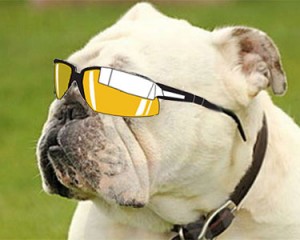Listening Post: Dog TV and cybugs
New media is starting to get a little old, if you think of it as a person sitting in front of a computer and interacting with remote websites using such quaint equipment as mouse and keyboard. The technology evolves at warp speed, while we chug along on one-quarter impulse power. But don’t worry about human limitation–it’s not just for humans anymore.
For example, Dog TV is coming to Direc TV next month. If you are a fan of Christmas movies and are old enough to remember Bill Murray’s Scrooged, you were present at the inception of this concept. Robert Mitchum plays a dotty studio executive, Preston Rhinelander, who pitches the idea of programs designed solely for stay-at-home pets. It was played completely for laughs then, but no more. You can watch some sample video at NPR’s blog The Two- Way, as it covers the August 1 national roll-out of the new channel. There will be three categories or programming on the channel: “stimulation,” “relaxation” and “exposure” (to oddities in a human-dominated environment). Cats presumably will be demanding their own channel. And I don’t want to know what ferrets would like to watch.
Also from NPR this week is “Do Dogs Think?” by Barbara J. King of the 13.7 blog. I recommend the included video, that should become a hit on Dog TV. A dog leaps for a branch, swings by his teeth, drops to the ground, and goes back for more. Presumably, this would be an example of “stimulation” programming. It also might be an educational program, in that the playful swinging dog later uses the technique he mastered in the video to escape from an enclosure. In the post, King’s 13.7 debate partner, Globe and Mail columnist Sarah Hampson, takes issue with the notion of dogs as thinking beings, but qualifies that by adding, “they don’t think as much as we do.” I say, let’s keep it that way.
A more sinister note on animal-computer interface surfaced recently on Fox News, in an article entitled “June Beetles Conscripted Into Cyborg Army”:
Military, commercial and academic defense research teams have been busy turning beetles and bees into cybugs, eeny-weeny cyborgs that will serve as unmanned aerial vehicles (UAVs) — tiny, living versions of drone aircraft.
Yikes!
And the last tech-nouveau nugget from NPR is a forecast of the near future by science fiction writer David Brin, who predicted something like Google Glass in his 1990 novel Earth. Some cautionary notes from him:
Distracted drivers will get into accidents or distracted lens wearers could walk off curbs or into moving vehicles. As Brin says, “Duh.”
Everyone [using Google Glass] would have “electronic name tags” on, along with background data about one another. “You’d never be at a loss,” says Brin.
This would be great for me. The space in my brain that most people use to remember names and faces is fully occupied by the lyrics to all the songs I heard in the ’60s.
Bill Haenel brought all these threads together for me, suggesting that Google Glass-wearing dogs will soon be keeping us all under surveillance. I bet they will discover a lot of humans are zoned out, secretly watching their favorite reruns on Dog TV.
Tags: listeningpost, new media, technology







.png)

Wait, wait, don’t tell me….where did I first read of Dog TV? Can’t remember. Anybody?
How much is that doggie in the window, anyway?
You’re really going to stample antlers to its head??? – What a great movie!
Remember “The Barefoot Executive” where a chimpanzee (with Kurt Russell and Harry Morgan(?)) predicts what TV shows will be popular? Maybe commentary on our habits? New tech, old habits.
Yes, the army is experimenting with cockroaches wearing tiny, cute transmitter backpacks to find survivors in rubble situations (like after earthquakes). Help is on the way! (if the cockroaches don’t get you first!) Also, thankfully, the navy no longer uses dolfins to find sea-mines – they’re now using robot-dolfins.